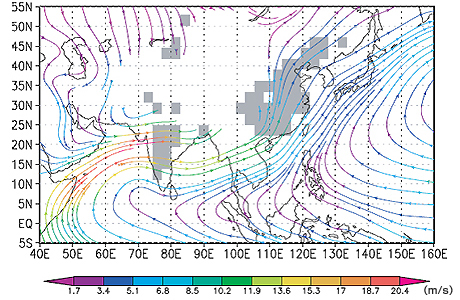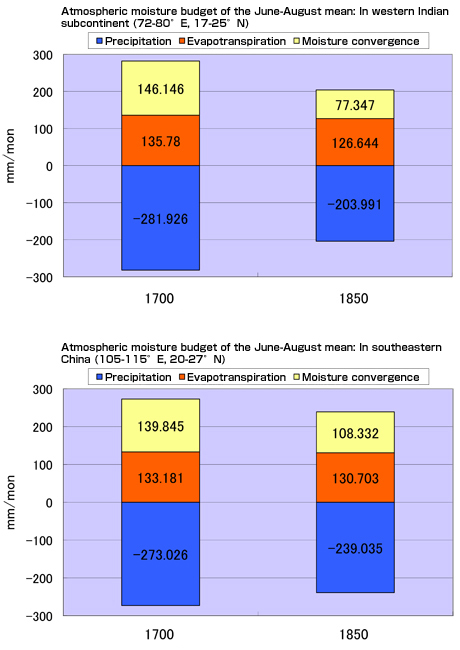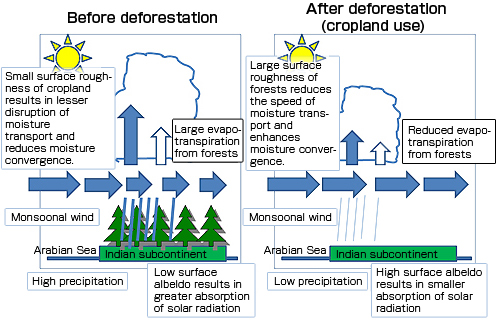

June 2, 2009
Japan Agency for Marine-Earth Science and Technology
Nagoya University
Climate Simulations Reveal Impact of Agricultural Development in Pre-Industrial Period
~Increased Land Cover during18th-19th Centuries led to Substantial Decrease
in Asian Monsoon Rainfall~
1. Outline
A new study shows for the first time that extensive deforestation could have been a major factor causing a substantial decrease in Asian monsoon rainfall over India and China during the 18th and 19th centuries, according to a group of researchers composed of Kumiko Takata, a senior scientist at the Global Hydro-climate Process Research Team of the Research Institute for Global Change at the Japan Agency for Marine-Science and Technology (JAMSTEC: Yasuhiro Kato, President), and Professor Yasunari Tetsuzo, Hydrosphere Atmospheric Research Center(HyARC) at the Nagoya University.
Using an Atmospheric General Circulation Model (AGCM), they examined the impact of land use change on the Asian monsoonal precipitation in preindustrial times. The results showed that conversion from forest to cropland increased surface albedo (ratio of solar radiation reflectance) and decreased ground surface roughness, weakening evapotranspiration (the sum of evaporation and plant transpiration) and convergence of moisture flux from the ocean. Such changes in atmospheric moisture balance reduced the supply of moisture to the atmosphere, leading to a decline in precipitation.
These findings suggest that it is highly likely that human-induced climate change associated with the expansion of crop land, had already been occurring in Asia before the onset of the industrial revolution which triggered a rise in greenhouse gas emissions.
The study was supported by the Global Environment Research Fund of the Ministry of the Environment, Japan: "Qualitative Assessment and Prediction of Asian Monsoon Change Induced by Human Activities." and will appear the week of June 1 in the online Early Edition of the Proceedings of the National Academy of Sciences of the USA (PNAS).
| Title | : | Changes in the Asian monsoon climate during 1700-1850 induced by preindustrial cultivation |
| Authors | : | Kumiko Takata, Kazuyuki Saito and Tetsuzo Yasunari |
2. Background
Climate change projections induced by increasing greenhouse gas emissions (e.g. CO2), along with impact assessments and mitigation measures are the primary objectives addressed by the Intergovernmental Panel on climate Change (IPCC). Whilst in Asian countries including Japan, the most immediate and important issue involving the climate projection is to clarify how the monsoon activity and precipitation would change by climate change.
Yet, many questions about feedback processes between atmosphere, land and the ocean for Asian monsoons are still unanswered; therefore, the projections on Asian monsoonal precipitation have not yielded results backed up by solid scientific evidence.
In particular, although land cover conditions play an important role in governing the monsoon activity, the impacts (or possible impacts) of land cover/use change on Asian monsoons have been studied only for specific regions and limited factors. Very few precedent studies have characterized Asian monsoon variations and explored relationships between historical land cover changes and climate change.
The group conducted numerical experiments using the AGCM to simulate how Asian monsoons would be affected by converting forests to cropland in the Indian and Chinese monsoon regions over 150 years between 1700 and 1850 (Fig. 1).
3. Method
Using two reconstructed historical datasets on global vegetation distribution (including cropland cover) in 1700 and 1850 as the lower boundary conditions for the AGCM, the team performed numerical experiments to simulate average states of summer (June, July, and August) for each time-periods. The results were then compared to examine the impact of deforestation for cropland use. In the both experiments the present-day monthly distributions of sea surface temperature (SST) and sea ice were prescribed.
4. Results and discussion
The simulation results showed that the amounts of summer monsoon precipitation in the 1850s, when a large forested area has been cleared for cropland, decreased by approximately 30 percent in the western Indian subcontinent and by about 10 percent in southeastern China from the 1700 levels (Fig. 2).
The conversion from forest to cropland was found to increase surface albedo and decrease land surface roughness, which resulted in reduced evapotranspiration and convergence of moisture flux from the ocean, and precipitation decrease (Fig. 3, 4).
The decreased precipitation between 1700 and 1850 was consistent with the results from a recent ice core analysis of a Himalayan glacier; the monsoonal precipitation in the western Indian subcontinent was higher in the 1700s than that in the 1800s. Ice core analysis is widely used as a tool to determine climate conditions in times before systematic meteorological observations were introduced.
Furthermore, the industrial revolution had not yet taken hold in Europe before 1850; therefore, anthropogenic increases in greenhouse gases and aerosols associated with industrial air pollution were still considered to be minor. In addition, no historical observational data presented natural disturbances, such as solar activity and volcanic eruptions, which may have caused global climatic trend during the concurrent period. These findings suggest that the simulated changes in the Asian monsoon climate associated with expanded cropland were very likely to happen during the 18th and 19th centuries.
5. Future perspective
The results revealed the measurable impact of land cover/use change on the Asian monsoon climate in addition to greenhouse gas increases. These findings are largely expected to provide new insights into the projection of water cycle and precipitation of Asian monsoons. The projections in these areas still have a large level of uncertainty compared to other IPCC’s climate change projections.
The findings may also have ripple effects on climate change measures in Asian countries; they suggest that in addition to the buildup of greenhouse gases and aerosols, land use changes (e.g. deforestation, desertification and large-scale urbanization) could have large effects on regional climate patterns including water resources issues.
- Figure 1: Land cover/use changes between 1700 and 1850 (shades) and 850-hPa wind field in June–August (streamlines with colors in meters s-1) in the experiment for 1850.

Extensive deforestation for cropland was observed in the Indian subcontinent (southern portion of 25°N) and eastern China (eastern portion of 100°E). Typically, Asian monsoon wind blows from the western Indian Ocean towards the Arabian Sea. The wind then shifts its direction to eastward, blowing across the Indian subcontinent to Bay of Bengal and the Indo-china Peninsula, becoming a northwesterly wind as it reaches eastern China and Japan.
- Figure 2: June-August mean precipitation changes between 1700 and 1850. In the western Indian subcontinent, the precipitation decreased by 2.6mm per day from 9.4mm per day (approximately 30% decrease). In southeastern China, it decreased by 1.1mm per day from 9.1mm per day (approximately 10% decrease).

- Figure 3:Atmospheric moisture budget of the June-August mean for 1700 and 1850 (mm month-1)

The atmospheric moisture budget depends on the balance between moisture convergence, evapotranspiration and precipitation. The positive values in the bar chart represent water vapor supply to the atmosphere (evapotranspiration and moisture flux convergence), and the negative values represent water vapor removed from the atmospheric (precipitation). The increase in surface albedo associated with cropland expansion reduces total evapotranspiration amounts. The decrease in ground surface roughness weakens the moisture convergence. The combined effect of both led to the decreases in precipitation.
- Figure 4: Schematic diagram of relation between moisture transport, precipitation and land-surface evapotranspiration over Indian subcontinent.

The horizontal thick blue arrows denote moisture transport (longer arrows indicate higher transport rates). The upward blue arrows are for moisture convergence associated with horizontal changes in moisture transport. The outlined arrows are for evapotranspiration. Water vapor from moisture convergence and evapotranspiration is condensed to form clouds, and then precipitation.
Contacts:
- (For the study)
-
Kumiko Takata
Global Hydro-climate Process Research Team
Research Institute for Global Change
Japan Agency for Marine-Science and Technology
Prof. Yasunari Tetsuzo
Hydrosphere Atmospheric Research Center (HyARC)
Nagoya University
- (For Publication)
-
Noriyuki Murata, e-mail: press@jamstec.go.jp
Manager, Planning Department Press Office
Japan Agency for Marine-Earth Science and Technology
Mr. Takeuchi Shoji
Public Relation’s Office
Nagoya University